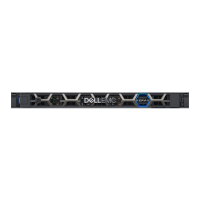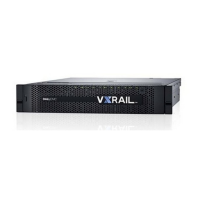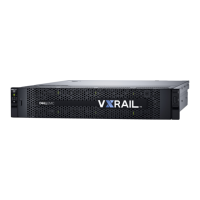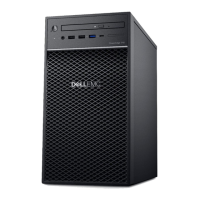12 | Network Planning Guide
© 2018 Dell Inc. or its subsidiaries
• At the time of VxRail deployment, you must choose the method of network switch configuration. Enabling the VxRail
personality profile on the switches resets the switches to the default state, and passes switch configuration responsibility to
VxRail. If you choose this method, all of the switch configuration functionality except basic management functions are disabled
at the console, and VxRail and the Dell-EMC OMNI plug-in are the tools going forward for network switch configuration
management.
• The Dell network switches enabled in VxRail personality profile mode can support no other connected devices except VxRail
nodes.
• You must deploy a separate Ethernet switch to support out-of-band management for the iDRAC feature on the VxRail nodes.
• Configuring Dell switches using SmartFabric mode does not use standard OS10 commands on the console to configure the
switches. The representation of the switch configuration from the console is not in sync with the SmartFabric configuration.
• Disabling the VxRail personality profile on the Dell network switches will delete the network configuration set up by
SmartFabric services. If a VxRail cluster is operational on the Dell switch fabric, the cluster must be deployed.
vSAN Stretched Cluster
vSAN stretched cluster is a VMware solution to support synchronous I/O on a vSAN datastore over distance, and is supported on
VxRail. A vSAN stretched cluster enables site-level failure protection with no loss
of service or loss of data.
If your plans include the deployment of vSAN stretched cluster on VxRail, make
note of the following requirements:
• Three data center sites required: two data center sites (Primary and
Secondary) host the VxRail infrastructure, and the third site is required to
support a witness to monitor the stretched cluster
• A minimum of 3 VxRail nodes is required in the Primary site, and a minimum
of 3 VxRail nodes is required in the Secondary site
• A minimum of 1 top-of-rack switch for the VxRail nodes is required in the
Primary and Secondary sites
• An ESXi instance is required at the Witness site
The vSAN stretched cluster feature has strict networking guidelines, specifically
for the WAN, that must be adhered to for the solution to work.
More detailed information on vSAN stretched cluster and the networking requirements is located here:
https://www.dellemc.com/resources/en-us/asset/white-papers/products/converged-infrastructure/h15275-vxrail-planning-
guide-virtual-san-stretched-cluster.pdf
VxRail Hardware and Switch Selection Decision Points
Step 1. Assess your requirements and perform a sizing exercise to decide on the quantity and characteristics of the
VxRail nodes you need to meet planned workload and targeted use cases
Step 2.
Determine the optimal VxRail port speed to meet planned workload requirements, and to calculate the number of
physical switch ports for connectivity
o VxRail supports 1GbE, 10GbE and 25GbE connectivity options
o VxRail supports either 2 or 4 connections per node to the physical switch
Step 3.
Decide whether you want to attach the VxRail nodes to the switches with RJ45 connections or SFP+ connections
o VxRail nodes with RJ-45 ports require CAT5 or CAT6 cables. CAT6 cables are included with every VxRail

